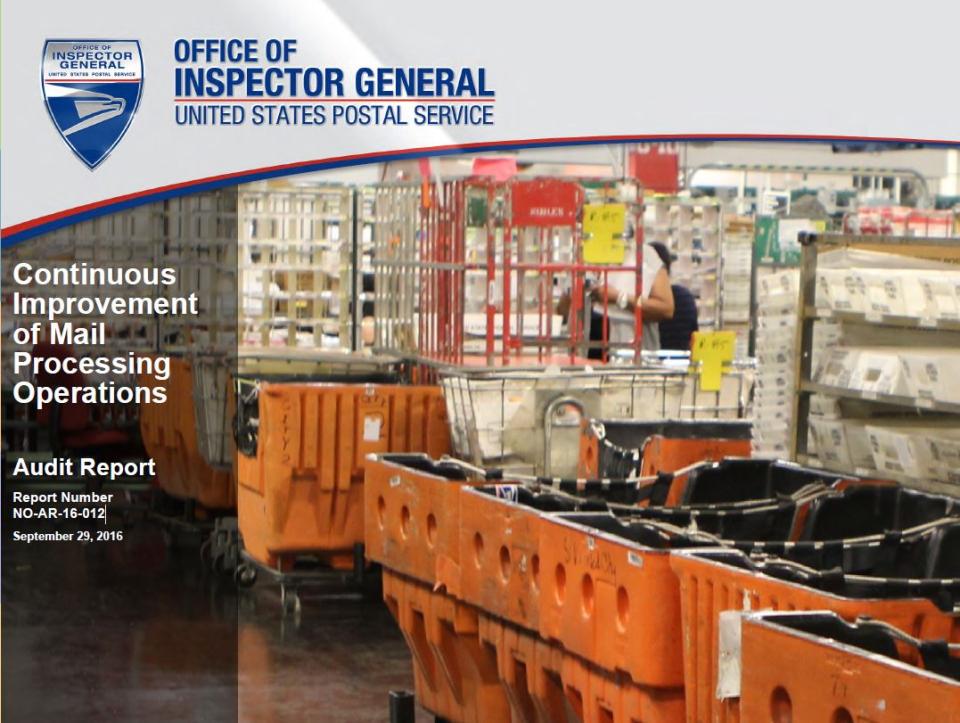Continuous Improvement of Mail Processing Operations
Background
The U.S. Postal Service has about 265 mail processing facilities nationwide. Mail processing is an integrated group of activities required to sort and distribute mail for dispatch and eventual delivery. The Postal Service defines mail processing efficiency as mailpieces sorted per workhour. One tool the Postal Service uses to compare mail processing operations performance to efficiency targets is the Mail Processing Variance (MPV) model, which calculates workhour performance using efficiency targets.
We evaluated mail processing efficiency by Labor Distribution Code (LDC), which identifies major work assignments for employees; and focused on efficiencies in the automated letters, flats, and packages; trays and bundles; and manual and other indirect mail operations.
In addition, we conducted site observations at North Texas, Trenton, and Sacramento Processing and Distribution Centers (P&DC) because the MPV model identified them as having high efficiency in specific processing operations. For example, high performing sites all had current, updated operating plans.
We also conducted site observations at the Boston, Raleigh, and Richmond P&DCs because the MPV model identified them as having low efficiency in specific processing operations.
We compared each plant’s efficiency to the national average MPV efficiency level and identified workhour savings opportunities.
Our objective was to evaluate the efficiency of the Postal Service’s fiscal year (FY) 2015 mail processing operations.
What the OIG Found
We identified mail processing efficiency opportunities that would save the Postal Service about $473.8 million annually by reducing more than 11.5 million workhours. For processing facilities below national average MPV efficiencies, there are opportunities to increase efficiency to the national average by reducing about 7 million workhours in the automated letters and flats, manual, and other indirect mail operations. For processing facilities below the national percent achievement to the MPV target for automated packages, trays, and bundles, there is an opportunity to increase efficiency to the national percent achievement by reducing about 4.5 million workhours. Based on our observations at the three P&DCs that had low efficiency, this occurred because machine throughput (the rate at which machines process mail) was as much as 22 percent below the national average. Machine jam rates were as much as 35 percent higher than the national average. In addition, mail was not adequately prepared; machine feed stations ran out of mail; and machine operators did not properly align the edges of the mail (jog) or remove mailpieces that were too thick, stiff, long, or tall (cull) for automated processing.
We also noted issues related to inadequate management and supervision, including failure to update operating plans, follow daily machine schedules (run plans) for mail processing, and ensure automated processing began promptly when employees started work. Finally, supervisors did not ensure employees clocked into the operation number where work was being performed.
The Postal Service’s projected overtime budget for FY 2015 was almost 8.9 million workhours, or about $332 million for the mail processing operations we reviewed. The actual overtime used was about 12.2 million hours, or $455.4 million. Reducing the excess 3.3 million workhours would have decreased costs by about $123 million.
The Postal Service reduced about 4,900 mail processing employees (or about 8.7 million mail processing workhours) through attrition in FY 2015.
The Postal Service had an opportunity to increase efficiency by reducing 11.5 million workhours from the LDCs we reviewed. As noted above, these workhour reduction opportunities could have come from the Postal Service meeting its projected overtime budget (3.3 million workhours) and not replacing employees reduced through attrition (8.7 million workhours).
What the OIG Recommended
We recommended the vice president, Network Operations, reduce 11.5 million workhours from projected FY 2016 levels where possible; and evaluate operational efficiency, adjust staffing levels/workhours to workload, and ensure overtime workhours do not exceed budgeted levels when planning for FY 2017 projected workhours.
We also recommended the vice president, Network Operations, direct district managers to ensure that plant managers make certain that operating plans are updated; daily machine schedules (run plans) for mail processing are followed; automated processing begins promptly after employees start work; and employees clock into the operation number where work is being performed and understand and use proper procedures for preparing, feeding, jogging, and culling mail prior to processing.

